Need for Speed
The Need for Speed
By Jack Mugan
Have you ever been browsing through one of you reference books and suddenly see a photo of an aircraft in markings you somehow missed before? That is what happened to me while reading my Squadron in action book on the F-86 Sabre, (No.126), and WHAM! There it was on page 32 and sporting a paint scheme I somehow missed seeing before. The photo was in black and white and I wasn't sure what the color was on the front third of the fuselage. It looked like white to me, but I was wrong.
So I did what I always do when I don't know something, I ask somebody. In this case I asked several model buddies and I was told that the color was Day-glo Orange, and that sealed the deal, I had to build this one. I started checking to see if there were any decals in 48th scale of this scheme, and discovered there were indeed, produced by Euro Decals, and available through . Their sheet called “Very Colorful Sabres” was soon winging its way to my mailbox.
What makes this jet so special and why the unusual paint scheme? Back in 1951 the Air Force wanted to set a new World Closed-Circuit Speed Record (100 Kilometers), so they took four newly minted F-86Es direct from the factory and painted them in this special color scheme, then numbered them one through four, and called upon COL Fred Ascani to do the flying honors during the Air Show in Detroit Michigan. Upon setting the new record of 635 mph, the four jets went straight from the speed test to combat with the 51st Fighter Interceptor Group in Korea. My first indication that this wasn't going to be a slam-dunk project was discovering that the Sabre was an “E” model, and you guessed it, nobody makes a 48th scale kit of this subject. I immediately contacted my Sabre “EXPERT” John Eian from the Twin Cities Aero Historians, my old club up north. John spent hours explaining the differences in the various Sabre marks, and told me the steps required to make an “E” out of an “F”, which made me stop and think how badly did I want to do this project.
The first thing I found was I was going to have to sacrifice a kit of the Sabre Dog made by Revell/Monogram for the wings. Fortunately this kit is reasonably priced, and John pointed out that I could use the “F” wings on the “D” as well, so that's was some comfort. As it turned out I already owned a kit of the “D” as well as the Hasegawa
F-86F-30 Sabre J.A.S.D.F. (No. 09500), so I was off to the races.
The “F” kit has a nice cockpit so the fuselage went together quickly and I was to the wing swap pretty fast. I spent a couple of days dry fitting the new wings and finally took the plunge. As it turned out, the fit was not as difficult as I thought it was going to be, just requiring that the wheel wells were aligned, a bit of putty and a little knife work on the leading edge where it meets the fuselage, and I now had an “E” model in hand.
The rest of the building process was simply out of the box, and now the painting was up next. I like to use ALCLAD paints when doing natural metal finishes, because they havea nice selection of shades of silver to choose from, and they dry very quickly as well. I also like to use TAMYIA tape for masking of the different panels and the clear canopy/windscreen parts, as it creates a good seal at the edge with hardly any bleed. I also often leave the tape down for long periods of time during some projects, and unlike some other tapes, it comes off clean leaving no residue.
I like to start with a coat of Alclad primer to check for seams and other problems, followed with a gentle scrubbing with a 3M plastic pad that will smooth things overall, and then I start with White Aluminum as a base coat. Now the fun starts. I try not to have too many panels with too many shades of metal. Looking at color photos helps identify the obvious different colored panels. I like to pick a few other panels using a subtle shade difference just to break up large areas of silver. I also used a Light Sea Grey on the main panels running the length of the wings, and the tail cap panel. When the panel work is complete, I like to give the whole model a thinned out coat of the White Aluminum to pull things together. This means leaving the tape on the grey panels of course. A coat of clear is applied next in preparation for the decals.
Anyone who has used Day-Glo Orange knows this is a tricky color to deal with. I started with a undercoat of flat white, followed by a coat of gloss white and then applied the Day-Glo. Great care is needed when removing your masking. I used a new X-Acto blade and cut along the tape edge to insure that the paint did not pull with the tape. This gave me a nice clean sharp paint edge.
A new problem arises when the research says the aircraft that set the actual record was the number two aircraft, and of course the decals have just the number four included on the sheet. This resulted in a bit of artwork on my part to produce a new number two, and some fancy cutting on the tail codes to match the correct aircraft.
Also missing was the nose copy saying U.S. AIR FORCE FLIGHT TEST CENTER EDWARDS A.F.B. As luck would have it, my computer has the stencil font on board, so I was able to scan the copy and reduce it to size on the printer, and then I was off to the local print shop to make new decals. The computer sure has been a great new tool for our hobby in so many ways.
The decals that come in the Hasegawa kit are very nice and the data stencils were used. At this time I sealed everything with a coat of ModelMaster Acrylic flat, which actually dries with a nice egg shell finish. All that remained was attaching of the landing gear and doors, the leading edge slats, main flaps, wing marker lights and pitot tube
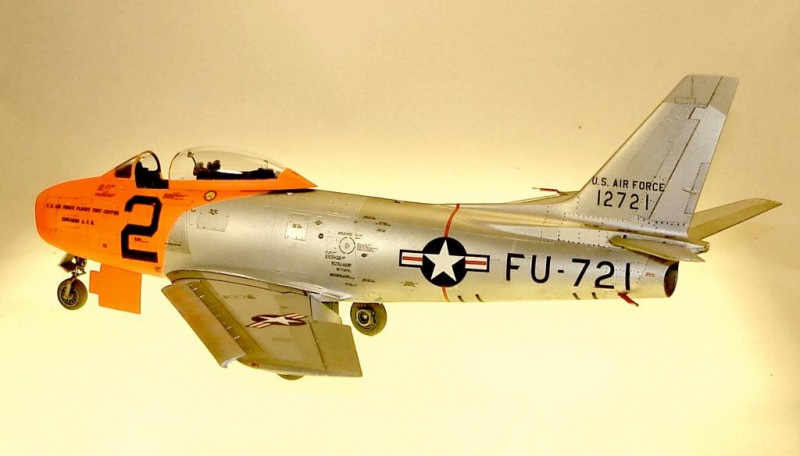
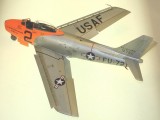
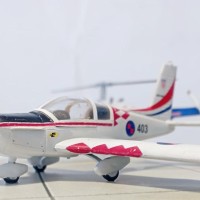
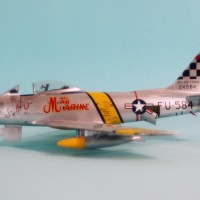
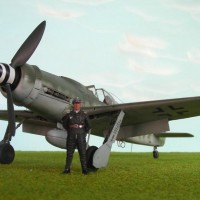

Beautiful Sabre, Jack...a really nice job.
Simply the best !
I meant to ask you earlier, Jack...please share with us your photographic technique(s) - how did you achieve such a pristine background with no shadows and the blending of the subtle shades of yellow/creme - it really brings the viewers eye to the model.
I assume it's some sort of photo program and not merely the lighting.
No, it is not a photo program. I have a small portable photo booth, the kind that is available at camera stores, and a small light box. The photo booth comes with two small lights, and I add another that is mounted directly above, and the light box provides light under the model to pick up the detail and remove shadows. I use a simple pocket camera, a Sony Cybershot, mounted on a try-pod. I know very little about photography and just stumbled on this combination.
Jack, it's a great looking Sabre, and thank you for sharing the whole story behind it. I happen to have the same Euro Decals sheet and this finish has been my favorite, second only to an all-red RCAF machine. Also, I wasn't aware about the speed record attempt, so thanks for the details about it. Keep up the good work /m
That's a real looker, and great cross-kitting work! Well done!
Magnus
soooo, my question is, what scheme can you use on the kitbash of the Sabredog with the Hasegawa wings, and did you build it?

Not as yet... not sure I can find the wings anymore. I did my "Dog" as Dennis the Menace (OOB). I still have a couple more in the stash, so I may get around to it yet. When and if I do, I'll have to research a scheme I suppose.
Jack,
Trying to catch up on my comments and went all the back to the site before I joined. Came across this and to say that I am impressed is an understatement. You do some outstanding work. Happy New Year and keep those e-mails coming. If you ever are looking for something let me know and I might be able to help. I have way too much C-rap and at my age will never get to it all.
Frank
Thanks for the nice words Frank and Happy New Year to you as well.